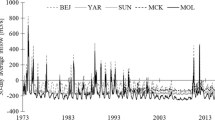Abstract
Distribution and percent cover of plant species in relation to hydroperiod (i.e., depth and duration of flooding) were examined along eight vegetation transects in Water Conservation Area 3A of the Everglades where water-level recorders were either present or subsequently installed. Transects were monitored between 1978 and 1984 to detect changes in plant communities resulting from the operation of water-control structures to improve distribution of water to WCA 3A. Hydroperiod increased significantly at four transects where long-term hydrologic data were available. Distribution of some obligate wetland species such asSagittaria lancifolia increased significantly with longer flooding duration. Several taxa, includingNymphaea odorata andUtricularia spp., showed significant positive relationships with annual increases in water depth.Typha domingensis increased in frequency and cover at two transects close to the northernmost water-control structure despite showing no significant relationship with increased hydroperiod. Therefore, it seems that some other environmental factor, such as inputs of phosphorus enriched water through the structure, may be encouraging the encroachment of this species. Improved hydroperiod may be inadequate for Everglades restoration without water quality improvements since it will likely result in monotypic stands ofT. domingensis.
Similar content being viewed by others
Literature Cited
Bennetts, R.E., M.W. Collopy, and S.R. Beissinger. 1988. Nesting ecology of snail kites in Water Conservation Area 3A. Department of Wildlife and Range Science, University of Florida, Gainesville, FL, USA. Florida Cooperative Fish and Wildlife Research Unit Technical Report. No. 31.
Davis, J.H. 1943. The natural features of southern Florida. Fla. Geol. Surv. Biol. Bull. No. 25. Tallahassee, FL, USA.
Davis, S.M. 1994. Phosphorus inputs and vegetation sensitivity in the Everglades. p. 357–378.In S.M. Davis and J.C. Ogden (eds.) Everglades: The Ecosystem and Its Restoration. St. Lucie Press, Delray Beach, FL, USA.
Daubenmire, R. 1959. A canopy-coverage method of vegetation analysis. Northwest Science 33:43–64.
Dineen, J.W. 1974. Examination of water management alternatives in Conservation Area 2A. In Depth Report 2(3):1–11, Central & Southern Flood Control District, West Palm Beach, FL, USA.
Frederick, P.C. 1994. Wading bird nesting success studies in the Water Conservation Areas of the Everglades. Report to the South Florida Water Management District, West Palm Beach, FL, USA.
Gerritsen, J. and H.S. Greening. 1989. Marsh seed banks of the Okefenokee Swamp: Effects of hydrologic regime and nutrients. Ecology 70:150–763.
Goodrick, R.L. 1984. The wet prairies of the northern Everglades. p. 185–190.In P.J. Gleason (ed.) Environments of South Florida Past and Present II. Miami Geological Society, Coral Gables, FL. USA.
Goodrick, R.L. and J.E. Milleson. 1974. Studies of floodplain vegetation and water level fluctuations in the Kissimmee River Valley. South Florida Water Management District Technical Publication 74–2. West Palm Beach, FL, USA.
Greening, H.S. and J. Gerritsen. 1987. Changes in macrophyte community structure following drought in the Okefenokee Swamp, Georgia, USA. Aquatic Botany 28:113–128.
Gunderson, L.H. 1989. Historical hydropatterns in wetland communities of Everglades National Park. p. 1099–1111.In R.R. Sharitz and J.W. Gibbons (eds.) Freshwater Wetlands and Wildlife. Symposiam Series No. 61 USDOE Office of Scientifie and Technical Information, Oak Ridge, TN, USA.
Gunderson, L.H. 1994. Vegetation of the Everglades: Determinants of community composition. p. 323–340.In S.M. Davis and J.C. Ogden (eds.) Everglades: The Ecosystem and its Restoration. St. Lucie Press, Delray Beach, FL, USA.
Hollander, M. and D.A. Wolfe. 1973. Nonparametric statistical methods. John Wiley and Sons, New York, NY, USA.
Koch, M.S. and K.R. Reddy. 1992. Distribution of soil and plant nutrients along a trophic gradient in the Florida Everglades. Soil Science Society of America Journal 56: 1492–1499.
Loveless, C.M. 1959. A study of the vegetation in the Florida Everglades. Ecology 40:1–9.
Mann, H.B. 1945. Nonparametric tests against trend. Econometrica 13:245–249.
McPherson, B.F. 1973. Vegetation in relation to water depth in Conservation Area 3, Florida. U.S. Geological Survey Open File Report No. 73025.
Ogden, J. 1994. A comparison of wading bird nesting colony dynamics (1931–1946 and 1974–1989) as an indication of ecosystem conditions in the southern Everglades. p. 533–570.In S.M. Davis and J.C. Ogden (eds.) Everglades: The Ecosystem and its Restoration. St. Lucie Press, Dclray Beach, FL, USA.
Rutchcy, K. and L. Vilchek. 1994. Development of an Everglades vegetation map using a SPOT image and Global Positioning System. Photogrammatic Engineering and Remote Sensing 60:767–775.
South Florida Water Management District. 1992. Surface water improvement and management plan for the Everglades. West Palm Beach, FL, USA.
Tabb, D.C. 1963. A summary of existing information on the freshwater, brackish water, and marine ecology of the Florida Everglades region in relation to freshwater needs of Everglades National Park. Report 630609. University of Miami Marine Laboratory, Miami, FL, USA.
Wood, J.M. and G.W. Tanner. 1990. Graminoid community composition and structure within four Everglades Management Areas. Wetlands 10:127–149.
Worth, D.F. 1988. Environmental response of WCA-2A to reduction in regulation schedule and marsh drawdown. South Florida Water Management District Technical Publication 88-02. West Palm Beach, FL, USA.
Zaffke, M. 1983. Plant communities of Water Conservation Area 3A: Base-line documentation prior to the operation of S-339 and S-340. South Florida Water Management District Technical Memorandum DRE-164. West Palm Beach, FL, USA.
Author information
Authors and Affiliations
Rights and permissions
About this article
Cite this article
David, P.G. Changes in plant communities relative to hydrologic conditions in the Florida Everglades. Wetlands 16, 15–23 (1996). https://doi.org/10.1007/BF03160642
Received:
Revised:
Accepted:
Issue Date:
DOI: https://doi.org/10.1007/BF03160642




